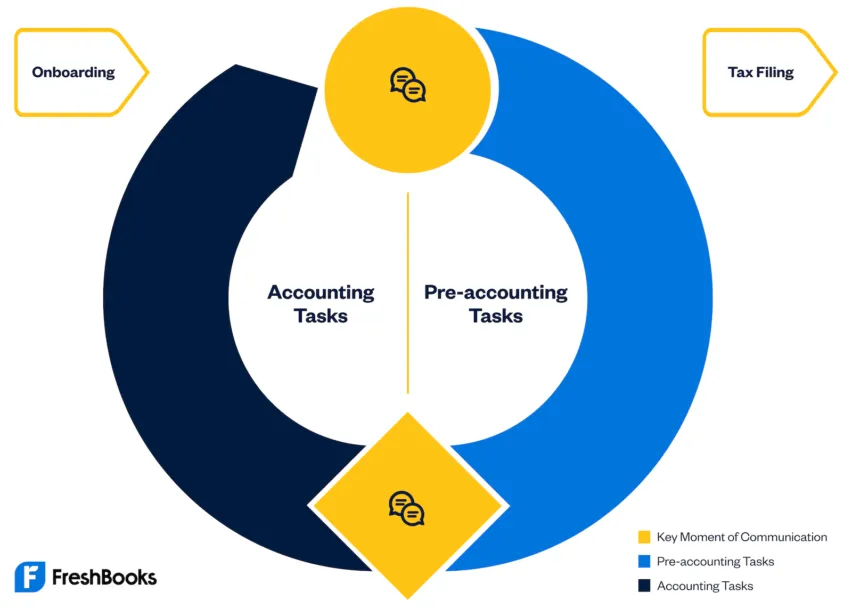Overcome your reluctance to involve clients in day-to-day operational tasks by embracing Collaborative Accounting™.

Are you anxious about having clients work with you on the books directly within your accounting platform?
I get it. This can be scary, especially if you’ve had clients make a mess of their books in the past. You often end up with more work than before, which probably strengthens your belief that it would’ve been easier to handle the task yourself.
The truth is, though, that some parts of the accounting workflow are best suited to your clients while others are suited to you. By empowering clients to tackle those workflows, you free up time to focus on those areas you’re best at. It’s a win-win.
But what exactly does empowering clients look like? What value does it provide? And how do you get started? Read on to learn more.
What Does Empowering Clients Entail?
Empowering your clients doesn’t mean you leave them to their own devices. And it’s not about getting clients to do more work. Instead, it’s about embracing a Collaborative Accounting methodology: An accounting model where accounting professionals work alongside their clients inside a shared, technology-enabled workflow in which each party owns key elements of the financial operations.
Accountants and clients work from a platform to handle tasks they’re best suited for. For accountants, these are high-level tasks like reports, journal entries, and analysis. For clients, these are pre-accounting tasks like expenses and bills, invoicing and payments, time tracking and payroll, projects and estimates, and proposals.
Why Should You Empower Your Clients?
Getting your clients involved in their own financial operations is the key to creating meaningful advisory relationships and it benefits both of you in different ways.
Clients Gain Deeper Understanding
When business owners handle the pre-accounting tasks they’re best equipped to deal with, they take charge of their daily operations and gain a deeper understanding of their own business. They’re able to come to the table in the business relationship, ready to gain real insights from advisory conversations with you.
Better Client Experience Overall
On the other hand, when clients don’t take ownership of their daily financials, they become detached from the financial heartbeat of their business, which can be hugely stressful. Empowering clients through the Collaborative Accounting model helps to alleviate this stress and opens up opportunities for advisory conversations.
Engaging in a shared workflow within a single system keeps communication streamlined and removes the frustration of hopping back and forth between different tools.
And, because you and your client are referencing the same information in the same place, you can easily work with them to help with pre-accounting tasks if they need it or to interpret data.
Kristen Keats, CPA, of Breakaway Bookkeeping & Advising, explains: “Having that transparency and visibility is huge. Because if [clients] get stuck at any point in the process, we’re able to jump in, in real-time, and help them get through the tasks that they need to be doing.”
You Have the Capacity for Advisory
When your clients handle parts of the workflow they’re best at, you free up time to focus on those parts you’re best at, like delivering advisory services to help clients achieve their business goals.
Nicole Davis, CPA, of Butler-Davis Tax & Accounting, agrees: “Now we’re able to spend much more time nurturing the client relationship, providing advisory and not just on the financial level but also the personal level.”
Your Skillset Will Shine
Client empowerment within a shared tech-enabled workflow provides transparency and real-time visibility into the client’s business that really helps facilitate the development of your advisory services.
“Our skillset really gets to shine because [the] insights are pulled out for us; we can work with them, we can go talk to our clients about what we’re seeing [and] how we can make decisions that could impact their business,” says Kenji Kuramoto of Acuity.
Your Business Can Scale Sustainably
You can expand your advisory services without having to grow your team. Nicole Davis explains: “Collaborative Accounting will empower me to scale my firm because I don’t have to worry about going back and cleaning up books. The client and I can work together from the start. It allows me to do more of the advisory-type services versus the compliance or the data entry.”
What Can You Do to Empower Clients?
Now that you understand the importance of empowering clients, let’s look at what you can do to empower them.
1. Embrace Collaborative Accounting™
A framework for client empowerment is built into the Collaborative Accounting model, and the self-directed, 4-hour Collaborative Accounting certification program provides a blueprint for you to follow, along with case studies and peer reviews.
But here’s a brief summary of how to start using this model with clients:
- Select the right technology. Look for accounting software that’s easy to use and provides seamless shared workflows between both clients and accountants.
- Set clients up for success with proper onboarding. Introduce Collaborative Accounting, explain how it can benefit them, and offer resources and training. Two important points you’ll also probably want to address are the client’s mindset about accounting and how to coach them to take on pre-accounting tasks (more on that below).
- Get hands-on. Tackle the accounting tasks and allow your clients to tackle the pre-accounting ones.
- Create advisory moments with clients: During onboarding, at handover, and at other key moments of communication.
2. Address the Client’s Mindset About Financial Tasks
Many clients don’t feel confident about completing certain financial tasks because they feel they don’t have the necessary skills. You can help them overcome this.
Highlight elements of the workflow they’re best equipped to take on—and why. This will provide some initial confidence.
Reassure them that tackling these tasks isn’t hard when using an intuitive platform that’s designed with ease of use in mind and has all the functions they need in one place—instead of disparate systems they may be using right now.
If they already have a bookkeeping system, switching to a new one can be challenging. “It takes work,” explains bookkeeper Kate Josephine Johnson of Heritage Business Services. “But if a business owner’s books are bad because they’re in bookkeeping software that is too complex and simultaneously too expensive, then it’s probably best to just rip off the band-aid and switch to software that will be more usable.”
3. Coach Clients to Take on Pre-Accounting Tasks
With clients tackling pre-accounting tasks under Collaborative Accounting, here are some ways you can coach them to take them on:
- Meet clients where they are. Understand their current expertise and knowledge in handling the pre-accounting tasks. This will help you tailor the coaching and resources you provide.
- Give them initial and ongoing training and resources like one-on-one coaching, regular workshops, education materials, and checklists for pre-accounting tasks. These resources serve as important references for your clients.
- Offer ongoing support. You need to be available to answer any questions clients may have as they tackle these tasks. You also want to encourage open communication so they feel comfortable contacting you anytime they’re struggling. So the burden isn’t entirely on you, opt for accounting software with excellent support for your clients, too.
- Break down tasks into smaller, manageable steps so they’re less intimidating. For example, before tackling all expenses, teach them to track a specific expense category.
- Select technology that’s easy to use. The right technology, like an easy-to-use accounting platform, facilitates the collaborative client-accountant relationship. For instance, Kristen Keats uses FreshBooks for real-time access and visibility. When clients need help, she and her team can immediately hop in to assist.
Rebecca Kittel, MBA, of Ledger Sense, feels it’s important to tailor coaching to each client. That starts with a conversation: “The best coaching happens when I’m able to hear and learn how clients are doing pre-accounting tasks during our onboarding or routine meetings,” explains Rebecca. “Old-fashioned one-on-one talking—something that is often missing in our technologically advanced world.”
She then follows up with more customized support, often in the form of a video response to questions or a visual walkthrough. “I purposefully do not provide materials upfront, I want to genuinely understand the business and their customer relationships, which happens naturally when we talk.”
Empower Your Clients Today
I understand you may be hesitant to empower clients to work on “accounting-type” tasks, but as you saw, there is real value to be had. When you empower clients within the framework of Collaborative Accounting, allowing them to focus on what they’re best at, you both win.
Clients take charge of their financials and get a better client experience. You, in turn, get more time to focus on advisory services, allow your skillset to shine, and are better poised to scale.
So, when you’re ready to get started, be sure to embrace Collaborative Accounting, address your client’s mindset, and coach them to take on those pre-accounting tasks. Once you’re up and running, you’ll wonder why it ever took you so long.

Written by Twyla Verhelst, CPA, Founder of the Accountant Channel, FreshBooks
Posted on November 8, 2023

 Build an Amazing Client Experience: 6 Great Accounting Customer Service Tips
Build an Amazing Client Experience: 6 Great Accounting Customer Service Tips Yes, Your Clients Can Handle Accounting Tasks. Here’s How.
Yes, Your Clients Can Handle Accounting Tasks. Here’s How. How Accounting Pro Rebecca Works Better With Clients in FreshBooks
How Accounting Pro Rebecca Works Better With Clients in FreshBooks





